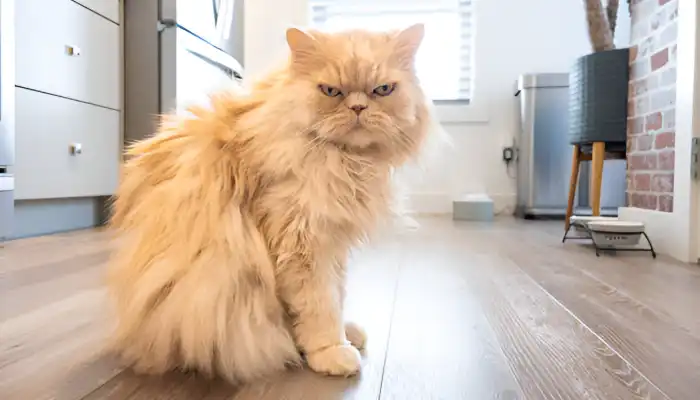How do cats say “I hate you”? It might seem like a cat can be said to ‘hate’, but it is crucial to understand that they don’t feel emotions in human categorization. Rather than expressing hatred, cats can show signs that may take the form of stress, frustration, or discomfort, which can be misinterpreted as aggression.
Learning how cats express these feelings, from body language to vocal sounds and even behaviors like avoiding contact, can give you insight into your cat’s behavior. In this article, I will cover the signs of cats’ negative emotions and what you can do to fix that relationship with the help of a cat translator.

Do cats experience “hate”?
How do cats say “I hate you”? First things first, is it even possible that cats can “hate” someone? The answer is not really. Cats indeed possess some kind of emotion, but unlike us, they express it differently.
- Humans vs. Cats: To us humans, the term “hate” is associated with an extreme form of anger or dislike. Unlike humans, cats do not have such a broad spectrum of complex emotions.
- Stress, Anxiety, and Frustration: Although cats might appear to show behavior that seems like “hate,” there can almost always be a case for fear, stress, or frustration as the driving force. Take, for instance, if a cat was to hiss at you, it should not be taken as a sign of hate at all—it is a possibility that they feel threatened.
In short, cats don’t actually “hate” us; their behavior is often a response to stress, fear, or frustration. Understanding these emotions helps improve your bond with your feline friend.
How Do Cats Express Negative Emotions?
Rather than hate, cats show displeasure or irritation through constant physical movements. So, if you’re wondering, How do cats say “I hate you”? It all comes down to their actions and gestures.
Postures And Body Movements
The first and most important thing is that a cat can now express and let out their negative feelings through their movement, known as body language. When he or she is feeling anxious or distressed, their stance can potentially give everything away.
- Flicking Tail: If your cat is agitated or irritated, it is a sign that their tail is twitching rapidly.
- Ears Falling Flat: Ears that are flat against the head of the cat are an indicator that they are in disagreement and not pleased.
- Body Tension: A body with a rigid or stiff body or crouching indicates discomfort or fear.
Table: The Body Language of Cats and What They Focus On
| Action | Significance |
|---|---|
| Tail Flicking | Anger, irritation or vexation |
| Ears Flattened | Anger, irritation, or vexation |
| Puffed-Up Fur | Scared or feeling unprotected |
| Slow Blinking | Relaxed, satisfied, trusting |
| Sudden Jumping/Swatting | Being frightened or perceiving danger |
Hissing and Growling
When wondering, How do cats say “I hate you”? It’s important to note that cats often express their displeasure through sounds like hissing and growling.
These distinctive noises indicate that your cat is upset or offended, and they are commonly used to warn or scare away perceived intruders, whether it’s another pet or a family member.
- Hissing: If you hear your cat hissing, it’s a good indication that your furry friend is feeling trapped and needs some personal space.
- Growling: Like hissing, growls indicate annoyance and a desire for people in your cat’s vicinity to gracefully retreat from their territory.
Avoidance Behavior
A more apparent indicator that a cat is expressing displeasure is avoidance. This can be in the form of a lack of contact and not wanting to be physically close to someone. A cat may not be vocal, unlike other pets, but it surely has feelings and emotions that can hurt if not expressed.
- Hiding: One of the more common behaviors that cats exhibit when they do not want any contact with you is hiding under beds, chairs, or couches.
- Avoiding Eye Contact: Cats often look away when they do not want to participate in a particular situation or when they are annoyed. If your cat is turning its back to you and not looking at you, it is likely in a state of disinterest or anger.
Cats communicate their negative emotions through body language and sounds, such as flicking tails, hissing, or avoiding contact. Understanding these cues helps us better respond to their needs and feelings.
How to Understand Your Cat’s Signals
How do cats say “I hate you”? Understanding your cat’s signals is essential for better communication. By paying attention to their body language and behaviors, you can decipher their feelings and meet their needs.”
Reading the Cat
This section covers handling the feline mystery that is your cat. Note that a cat’s tail dictates a lot of how your cat is feeling.
- Tail Position: A high tail indicates happiness. However, in low or tucked positions, it denotes fear.
- Eyes: Wide eyes in combination with dilated pupils may be the new sign for fear or excitement. While glaring or narrowing may signify irritation.
- Purring vs. Hissing: Generally speaking, cat purring means contentment. However, if the creature is purring and hissing simultaneously, then they are stressed, confused, or in dual fusion.
Taking Care of Your Cat’s Needs
Cats are very good at communicating their needs, and understanding them means trying to meet those needs. Here are ways to help boost your relationship.
- Honor Feline Circumference: Do not compel affection. Let your cat approach you whenever they’re ready.
- Give Them “You” Space: If your cat is withdrawing from you, give them the amount of time they need to settle down before trying to engage them once again.
By giving your cat space, ensuring they’re well-cared for, and building trust gradually, you can help ease their discomfort and strengthen your relationship over time.
Conclusion
How do cats say “I hate you”? The truth is, cats don’t actually “hate” anyone. Instead, they show frustration or discomfort through body language and behaviors like hissing, growling, or avoidance. While these signs might seem like negative emotions, they are often responses to stress, fear, or changes in their environment.
Understanding these signals can help you build a better bond with your cat. By respecting their space, providing attention, and monitoring their health, you can create a harmonious relationship and reduce any signs of aggression or distress.
